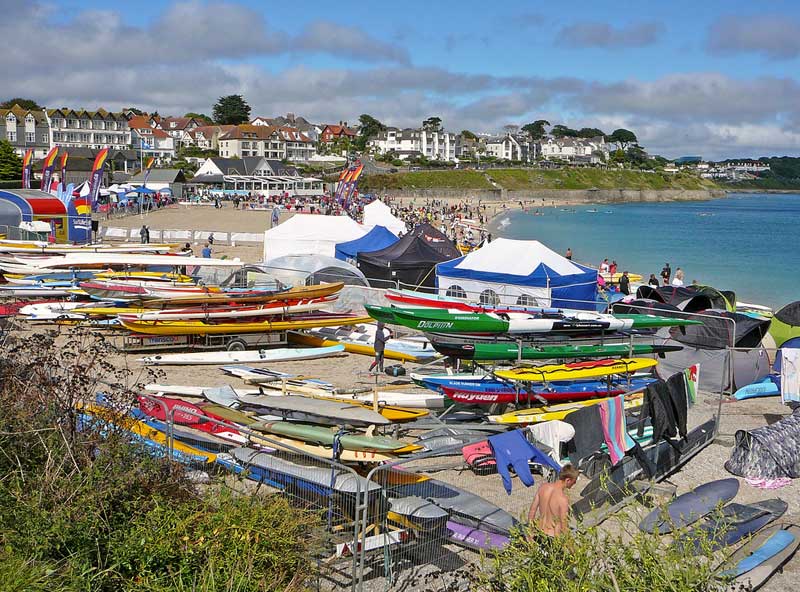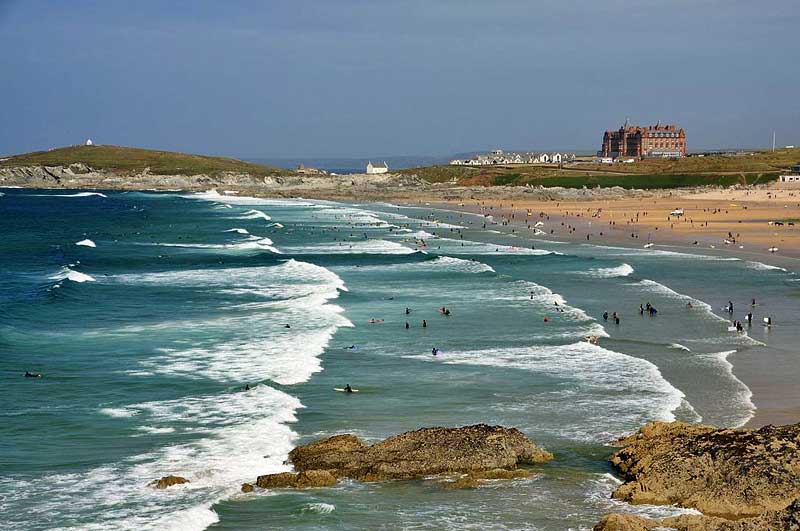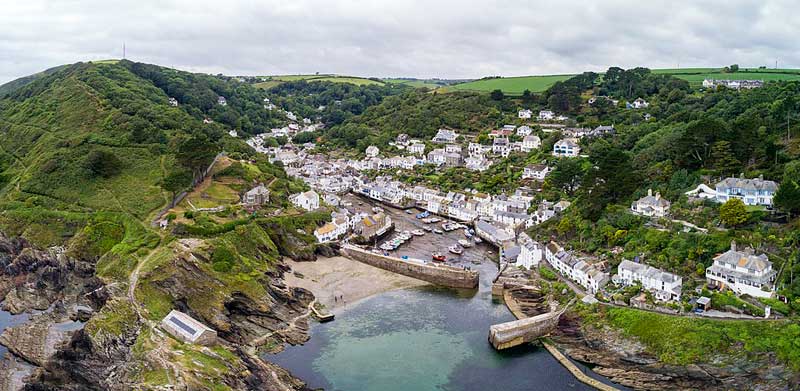Comprising over 300 miles of spectacular rugged coastline, Cornwall on the South West peninsula of England is a unique adventure destination. Stunning sandy beaches, wild oceans, undulating coastal paths, rolling countryside, quaint fishing villages and coastal towns provide a plethora of opportunities for outdoor fun!

“Canoes on Gyllyngvase Beach” by atoach
Adventure Highlights
Adventure highlights include surfing at the legendary Fistral Beach, walking the spectacular South West Coast Path, coasteering the rugged north cornish coastline and rock climbing the sea cliffs of Sennen.
Cornwall Activities
Places to Visit
To help plan your Cornwall road trip we’ve listed out some of the most popular places to visit.
Falmouth
The town of Falmouth is Cornwall’s largest port and a mecca for tourists throughout the summer months. Beautiful sandy beaches, attractive old shops, cafes, restaurants and a smattering of eclectic bars are just some of the reasons to visit. Gyllyngvase is a beautiful sandy beach popular with swimmers and paddle boarders – rental and lessons available at WeSUP. The Gylly Beach cafe at Gyllyngvase serves a super tasty locally sourced breakfast and has outdoor seating available.
Local Knowledge.
Drink with the locals in The Front cider & ale house, which also allows you to eat take-away food on the premises!
Talking of food, if you are partial to fish and chips the award winning Harbour Lights is worth the queue. Up the hill from town is Provedore, a small tapas bar and cafe which serves a mean breakfast and good coffee. With a growing student population Falmouth has some great drinking establishments including the Chintz Bar, The Boathouse and Beerwolf Books. On the cultural side the National Maritime Museum and Pendennis Castle are both centrally located.
Newquay
The seaside resort and surf town of Newquay is known for its sandy beaches and ocean swell. Its one of the most popular surfing locations in the UK, and favoured by many newbie surfers due to its choice of surf schools and plethora of surf shops. The famous Fistral beach is a surfing mecca and home to major UK surfing competitions including the Boardmasters, whose base is up the coast at Watergate bay. Away from the beaches, local attractions include Newquay Zoo and the Blue Reef Aquarium.
Foodies are spoilt for choice with a great selection of restaurants, local favourites include The Fish House and Kahuna. Newquay’s night scene has become more sophisticated over the years, although the cheese factor goes through the roof during the summer – popular venues include the Sailors Arms and Walkabout. The town becomes crowded during the peak summer months and accommodation is best booked early.

[By Nilfanion (Wikimedia UK) [CC BY-SA 4.0], via Wikimedia Commons]
Penzance
The port of Penzance on the south coast is sheltered by Mount’s Bay, and overlooks the fascinating St Michael’s Mount. The town is awash with palm trees and sub-tropical plants – evidence of its mild climate compared to much of the UK. Mooch around the town and you will discover art galleries, book shops, cafes and restaurants amongst a jumble of buildings and businesses. The historic Chapel Street is a highlight and leads down to the harbour.
South of the harbour is Penzance’s seafront promenade which is also a part of the South West Coast Path. If you fancy a dip the recently restored Jubilee pool is an art deco lido close to the harbour, which opens during the summer months. Day trips to the Isles of Scilly also set sail from the harbour.
Penzance is a great base for a trip to the world famous open-air Minack theatre, and to Land’s end for a walk around the headland of mainland England’s most westerly point.
Polperro
The fishing village of Polperro is a popular tourist destination set in an idyllic cove. Its narrow streets are home to a handful of pubs and cafes, along with numerous old fisherman’s houses overlooking a quaint harbour. If you want to experience Cornwall as it once was this a great detour to take.

[By Chensiyuan [CC BY-SA 4.0], from Wikimedia Commons]
St Ives
St Ives is renowned for its golden beaches and local arts scene, and is a hive of activity throughout the summer. Galleries, cafes, shops and eateries are strewn throughout its cobbled alleys and narrow streets. Take a wander around the old harbour or head to the popular beaches of Porthmeor, Porthminster or Porthgwidden – the latter being a tiny sheltered cove. In addition to the many local art galleries, St Ives is home to the stunning Tate St Ives which overlooks the Atlantic Ocean. For more crafty types the Sloop craft market is a must do. St Ives is accessible via train from London, with a journey time of approx 6 hours.
Truro
Cornwall’s capital Truro lies approx 9 miles inland and is a busy leisure and retail hub. The cathedral city sees the convergence of rivers into the head of the River Truro. A popular day trip in the summer is to take a river boat to the energetic maritime port of Falmouth. The fascinating Royal Cornwall Museum is centrally located and provides an insight into Cornish culture and arts. If you like your seafood, Hooked! is a highly rated restaurant and bar. Further afield, cider lovers should head to Healers Cyder Farm for a great family friendly day.
Cornwall Facts
- The highest point in Cornwall is Brown Willy, a hill on Bodmin Moor whose summit is 1,378 feet (420 m) above sea level.
- Lizard point is the most southerly point in Britain, whilst Land’s End is the westernmost point of mainland England.
- Approx half a million people live on Cornwall, or 0.75% of the UK population.
- At nearly 300 miles, Cornwall has the longest coastline of all the counties in Britain.
- Cornwall is steeped in smuggling history, with smugglers taking advantage of its extensive coastline to smuggle illegal contraband such as brandy, gin and tobacco.
- Cornwall was previously a world leader in the supply of tin and copper, with mining activities peaking in the early 1800s. Cornwall’s last tin mine closed in 1998.

